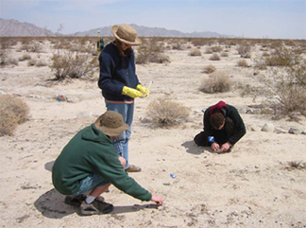|
Piedmonts, the low-gradient surfaces extending from mountain fronts to flat-lying basins, are a common feature of many desert landscapes. Piedmonts are particularly well developed in southwestern North America. Rapid population growth has brought people and their homes into close contact with piedmont surface processes including flash flooding, erosion, and sedimentation.
We have used a variety of techniques to understand better the response of desert piedmonts to changes in climate and land use. Using detailed surveys of sites occupied by Patton's troops and tanks over 50 years ago, we demonstrate that the hydrologic effects of tank track compaction and road building continue today. Sediment tracing with 10-Be and painted pebbles allows us to construct sediment budgets for piedmonts suggesting where sediment comes from and how rapidly it moves down piedmont. Such information is important for land management, particularly in areas where hazardous materials such as unexploded ordinance may also be moved by floods.
This research has been supported by the DoD.
Relevant Publications:
- Nichols, K.K, Bierman, P.R., Eppes, M. C., Finkel, R., Caffee, and Larsen, J., (2005) Late Pleistocene and Holocene history Mojave desert piedmonts, at Chemehuevi mountain and elsewhere, deciphered using 10Be and 26Al. American Journal of Science.
- Nichols, K.K, Bierman, P.R., Finkel, R., Caffee, and Larsen, J., (2005) Cosmogenically enabled sediment budgeting, GEOLOGY. 33: 133-136.
- Persico, L., Nichols, K, and Bierman, P.R., (2005) Tracking painted pebbles: rates of sediment movement on four Mojave desert piedmont surfaces. Water Resources Research, v. 41, W07004, doi:10.1029/2005WR003990, 2005
- Nichols, K.K., Bierman, P. R., and Caffee, M., (2002) Quantifying sediment transport on desert piedmonts using in situ produced 10Be and 26Al. Geomorphology. v. 45 (1,2), p. 89-104
- Nichols, K.K, and Bierman, P.R. (2001) Fifty four years of ephemeral channel response to intense military activity at Camp Iron Mountain, Mojave Desert, California, Environmental and Engineering Impacts of Military Operations. Geological Society of America Reviews of Engineering Geology, v. XIV. p. 123-136.
|




